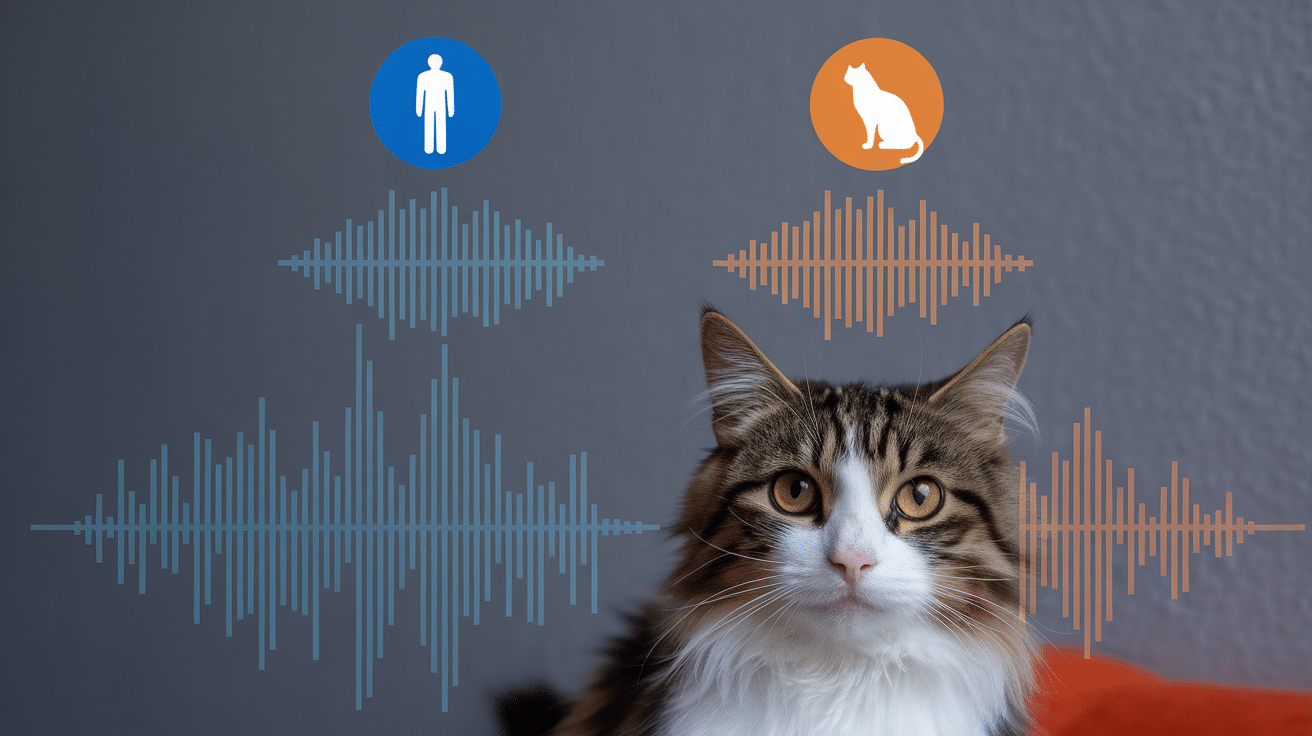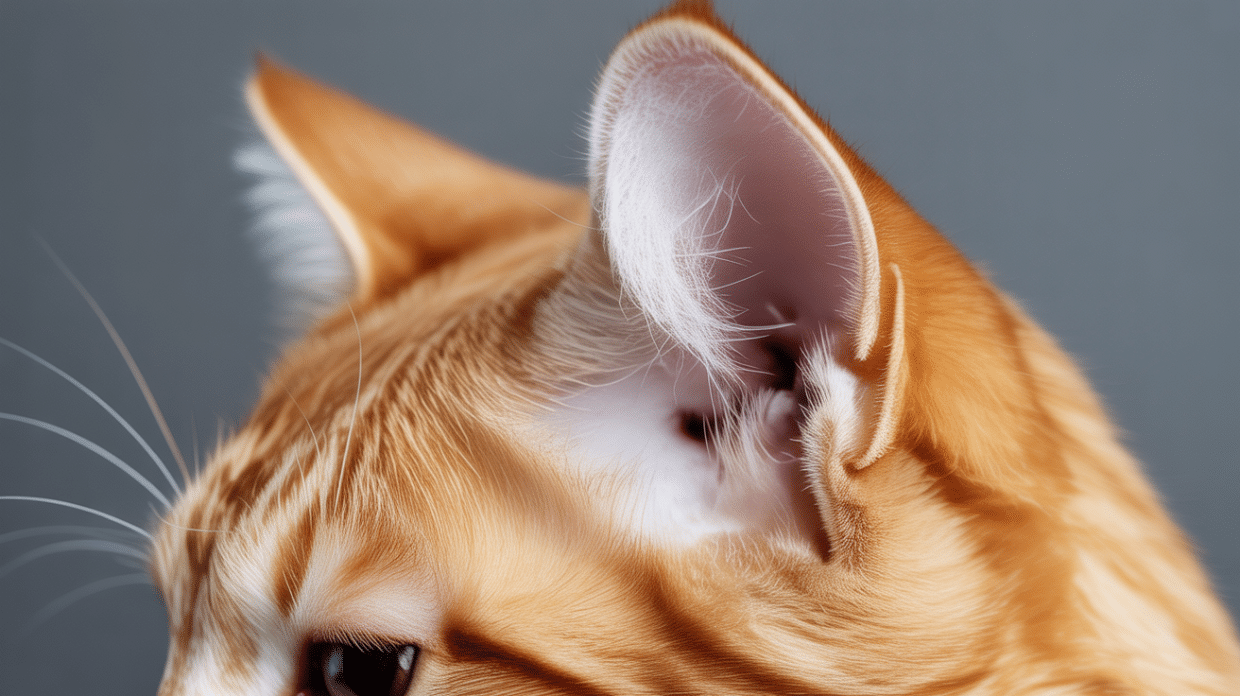Have you ever noticed how your cat’s ears move at the slightest sound? That’s because cats hear on a completely different level than we do.
Their ears are designed to detect a wider range of sounds, including those beyond our hearing abilities. From those quick ear twitches to their ability to pinpoint where a sound is coming from, cats have highly developed hearing.
In this article, we’ll take a closer look at how their ears work, comparing their hearing abilities with ours. We’ll cover everything from their impressive frequency range to how far they can hear and how accurately they can locate sounds.
Understanding these differences will help explain many of your cat’s behaviors and show you how to better care for your feline friend’s sensitive ears.
Hearing Range Comparison: Cats vs. Humans

The differences are quite striking when comparing the hearing abilities of cats and humans.
Both species can detect sound, but cats have developed a much wider range of hearing that gives them a clear advantage in the natural world.
Cats’ Frequency Range
Cats possess an extraordinary ability to detect sounds across a much broader spectrum than humans can perceive. Their highly specialized ear structure allows them to capture sounds completely silent to human ears.
| Species | Low-Frequency Range | High-Frequency Range |
|---|---|---|
| Cats | 48 Hz | 85,000 Hz |
| Humans | 20 Hz | 20,000 Hz |
Humans’ Frequency Range
While humans can detect very low sounds that cats miss (between 20-48 Hz), our hearing falls far short on the higher end.
The upper limit of human hearing, around 20,000 Hz, is less than a quarter of what cats can detect. This explains why ultrasonic pest repellers don’t bother humans but may upset cats in the home.
Why It Matters
This extended hearing range serves important functions for cats. Their ability to detect high-frequency sounds helps them locate small prey like mice, which make ultrasonic noises during movement.
This skill made cats valuable for controlling pests throughout history and remains useful today. Cats’ wide hearing range also helps them avoid predators and monitor their surroundings while sleeping.
How Cats’ Hearing Works
The impressive hearing abilities of cats come from the unique design of their ears, which have evolved over thousands of years to help them thrive as hunters.
1. Ear Structure
A cat’s ear consists of three main parts: the outer ear, middle ear, and inner ear.
The outer ear includes the visible part (pinna), which can rotate independently up to 180 degrees. This helps cats catch sounds from multiple directions without moving their heads.
This rotating ability acts like a sound funnel, directing noise into the ear canal more effectively than human ears can.
2. Sensitivity to Sounds
Cats show peak sensitivity to sounds around 8,000 Hz, which is also the frequency range where many small rodents communicate.
This is no accident; cats’ hearing has developed to make them excellent hunters of small prey. Their ear muscles are much more developed than humans’, allowing precise control and sound detection.
3. How Far Can Cats Hear?
Cats’ hearing distance is truly remarkable; they can detect sounds four to five times farther away than humans can.
Additionally, cats can pinpoint the source of a sound within 3 inches from a distance of up to 3 feet away, giving them incredible accuracy when hunting.
The Practical Benefits of Cats’ Exceptional Hearing

Their superior hearing gives cats several advantages that help them thrive in the wild and as pets in our homes.
Cats use their exceptional hearing to:
- Detect prey hiding inside walls or under floors
- Notice potential threats long before they become visible
- Pick up on subtle changes in their environment
- Understand human emotions through voice tone variations
Hunting and Survival
A cat’s hearing is crucial for finding food and staying safe in the wild.
They can hear the high-pitched squeaks of mice or the flutter of bird wings from impressive distances.
This skill translates to domestic settings where cats are often alert to pests in the home before humans notice any signs of infestation.
Communication
Cats rely heavily on hearing for social interaction. They can distinguish between human voices and recognize their owner’s footsteps.
Their sensitive ears pick up on tone variations, helping them interpret human emotions and respond accordingly, even when they seem to ignore you.
Hearing Issues in Cats
Despite their superior hearing abilities, cats can experience hearing problems like humans. Understanding these issues can help cat owners identify and address potential concerns early.
Common Hearing Problems
Cats may develop several types of hearing issues throughout their lives. Ear infections are among the most common problems, often caused by ear mites, bacteria, or yeast.
Other issues include polyps, tumors, or physical damage to the ear from injuries or fights with other animals. Some white cats with blue eyes have a genetic link to deafness from birth.
Older cats may also experience age-related hearing decline similar to humans.
How to Spot Hearing Loss
Watch for these signs:
- Not responding when called or to familiar sounds
- Being startled when approached
- Louder meowing than usual
- Sleeping more deeply
- Stopped responding to treat bags or can openers
If you notice these signs, consult your veterinarian. While many hearing issues can’t be reversed, early treatment of infections can prevent permanent damage.
For cats with permanent hearing loss, maintaining consistent routines and using visual cues for communication can help them adjust comfortably.
How Does a Cat’s Hearing Compare to Other Animals?
While cats have impressive hearing abilities, they’re not the only animals with specialized auditory systems. Let’s see how they stack up against other common animals.
Cats vs. Dogs
Both cats and dogs have hearing that surpasses humans, but they excel in different areas:
| Animal | Frequency Range | Distance Detection | Special Abilities |
|---|---|---|---|
| Cats | 48 Hz – 85,000 Hz | 4-5 times the human range | Best at pinpointing sound location |
| Dogs | 67 Hz – 45,000 Hz | 4 times the human range | Better at hearing low frequencies |
| Humans | 20 Hz – 20,000 Hz | Baseline | Better directional hearing than cats |
Why Cats Are Superior in Hearing
Cats have better hearing than dogs mainly because of their ear structure. Their ear canals are deeper, and they have 30 muscles controlling their ear movements compared to dogs’ 18.
Cats can rotate their ears independently and more extensively, helping them locate sounds more precisely.
Their greater sensitivity to high frequencies also gives them an advantage in detecting small prey animals communicating or moving in ultrasonic ranges.
This specialized hearing system evolved as cats developed as solitary hunters who rely on stealth and precision rather than pack-hunting strategies.
Tips for Cat Owners

Understanding your cat’s sensitive hearing can help you create a more comfortable living environment and avoid unnecessary stress for your feline friend.
Avoiding Sound Overload
Cats’ sensitive hearing means they can become stressed when exposed to loud noises. Common household items like vacuum cleaners, blenders, and loud music can be uncomfortable or even painful to cats.
Many cats hide during thunderstorms or when fireworks go off; this is a direct response to the overwhelming sound levels they experience.
Prolonged exposure to loud noises can lead to anxiety, behavior problems, and potentially hearing damage in cats.
Pay attention to your cat’s reactions to different sounds, and keep noise levels reasonable, especially if your cat shows signs of distress.
Creating a Cat-Friendly Sound Environment
- Provide quiet retreat spaces for your cat to escape when things get noisy
- Give a warning before using loud appliances
- Use noise-reducing pads under vibrating appliances
- Consider using white noise machines to mask disturbing outside sounds
- Avoid sudden loud noises like slamming doors
Conclusion
Cats have amazing hearing that’s much better than ours. Their ears help them hear sounds from far away, pick up noises we can’t even hear, and figure out where sounds are coming from.
These abilities helped them survive as hunters and still influence their behavior today. With their sharp hearing, cats can detect prey, avoid danger, and even understand our moods by how we speak.
Now that you know how impressive their hearing is, you can make your home more comfortable by reducing loud noises and giving them quiet spots to relax.
For more tips on taking care of your cat, check out similar articles on our website!






